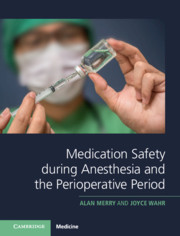Book contents
- Medication Safety during Anesthesia and the Perioperative Period
- Medication Safety during Anesthesia and the Perioperative Period
- Copyright page
- Dedication
- The Snow Vaporizer, Mark II
- Contents
- Foreword
- Acknowledgments
- 1 Introduction to Medication Safety in Anesthesia and the Perioperative Period
- 2 Failures in Medication Safety during Anesthesia and the Perioperative Period
- 3 Failures in Medication Safety in the Intensive Care Unit and Ward
- 4 Impact of Medication Errors on the Patient and Family
- 5 Consequences for the Practitioner
- 6 Why Failures Occur in the Safe Management of Medications
- 7 Errors in the Context of the Perioperative Administration of Medications
- 8 Violations and Medication Safety
- 9 Interventions to Improve Medication Safety
- 10 Medication Safety in Special Contexts
- 11 Legal and Regulatory Responses to Avoidable Adverse Medication Events, Part I: General Principles
- 12 Legal and Regulatory Responses to Avoidable Adverse Medication Events, Part II: Practical Examples
- 13 Barriers to Improving Medication Safety
- 14 Conclusions
- Index
- References
1 - Introduction to Medication Safety in Anesthesia and the Perioperative Period
Published online by Cambridge University Press: 09 April 2021
- Medication Safety during Anesthesia and the Perioperative Period
- Medication Safety during Anesthesia and the Perioperative Period
- Copyright page
- Dedication
- The Snow Vaporizer, Mark II
- Contents
- Foreword
- Acknowledgments
- 1 Introduction to Medication Safety in Anesthesia and the Perioperative Period
- 2 Failures in Medication Safety during Anesthesia and the Perioperative Period
- 3 Failures in Medication Safety in the Intensive Care Unit and Ward
- 4 Impact of Medication Errors on the Patient and Family
- 5 Consequences for the Practitioner
- 6 Why Failures Occur in the Safe Management of Medications
- 7 Errors in the Context of the Perioperative Administration of Medications
- 8 Violations and Medication Safety
- 9 Interventions to Improve Medication Safety
- 10 Medication Safety in Special Contexts
- 11 Legal and Regulatory Responses to Avoidable Adverse Medication Events, Part I: General Principles
- 12 Legal and Regulatory Responses to Avoidable Adverse Medication Events, Part II: Practical Examples
- 13 Barriers to Improving Medication Safety
- 14 Conclusions
- Index
- References
Summary
Medication errors are believed to be a leading cause of avoidable harm to patients around the world, with an estimated cost of US$42 billion per year, worldwide. It has been estimated that 5% of all patients who are admitted to a hospital experience a medication error, and that an average hospital will have one medication error every 22.7 hours or every 19.7 admissions. Human error is inevitable, but many of these errors actually reflect failures in the design and resourcing of the system within which medications are administered to patients, and some reflect violations of safe medication practices. Medication errors are the most common of all medical errors and pose a tremendous emotional and physical cost to patients and economic burden to our health system. Clearly medication error is a major source of risk and adverse events for our patients. This chapter presents a roadmap for the rest of the book, and definitions that will be used throughout. We also discuss how medication error is measured, the methods by which it is studied, the techniques used to capture incident reports, and some of the metrics and statistics to report these errors and incidents.
Keywords
- Type
- Chapter
- Information
- Publisher: Cambridge University PressPrint publication year: 2021
References
- 1
- Cited by

